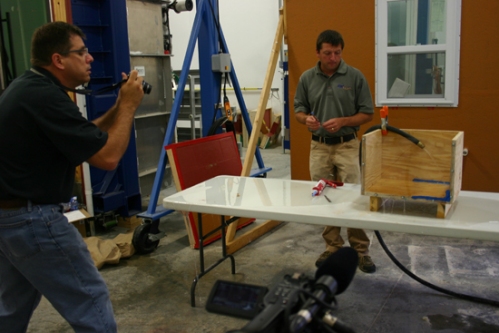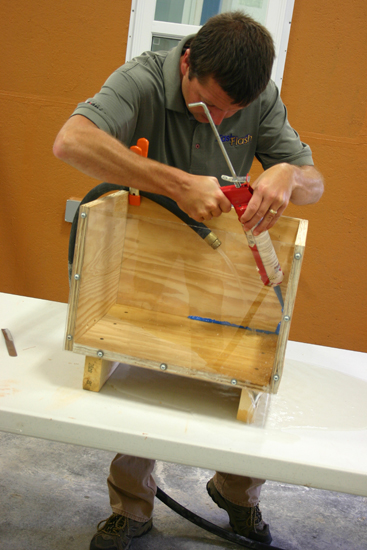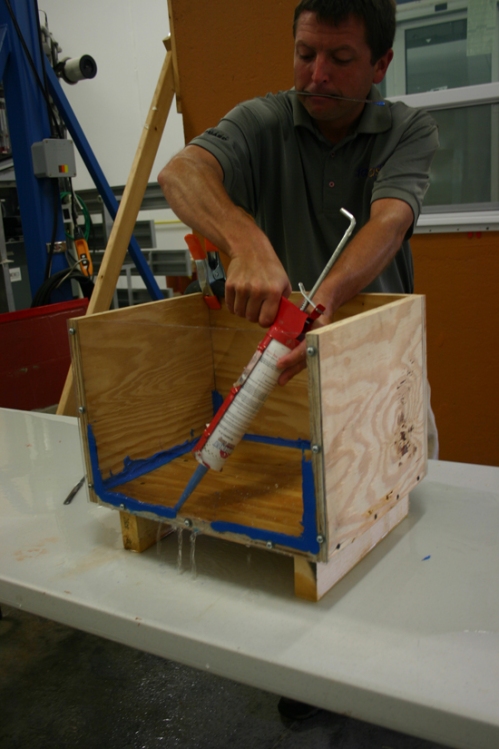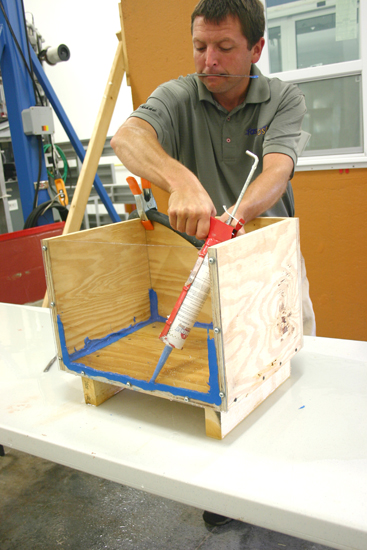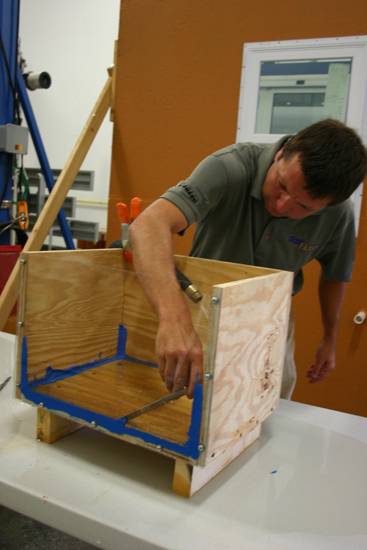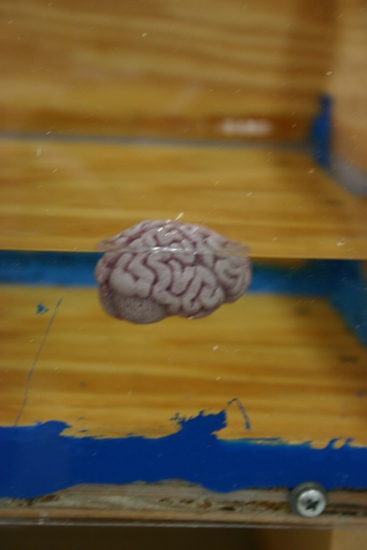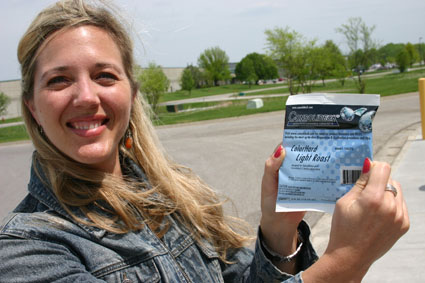Photos courtesy Carl Stein, Elemental Architecture
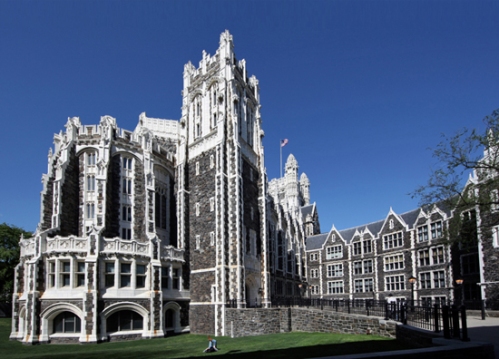
Shepard Hall (1907) City College of New York, clad in dark gray, locally quarried Manhattan Schist, features nearly 72,000 individual units of GFRC trim and ornamentation replacing failing terra cotta pieces.
There’s something grand about every high-profile restoration project, but Shepard Hall, City College of New York, with work spanning more than a quarter-century and $100 million, is truly epic in scope.
The project began in 1986 when the award-winning Stein Partnership, New York City, now Elemental Architecture, took on the job of determining how to save the 1907 Gothic Revival centerpiece of the college — if indeed it could be saved.
The building, designed by George Browne Post (1837-1913), was in dire condition inside and out, said Carl Stein, FAIA, one of the firm’s founders. Carl, author of Greening Modernism, published by W. W. Norton, has overseen the Shepard Hall restoration from the beginning.
Structural terra cotta, unable to cope with decades of freeze-thaw cycling and building movement had been failing for 60 years. In some places chunks, falling from the building, were replaced with brick and mortar.
“It wasn’t very pretty,” Carl said.
Of the 72,000 separate terra cotta pieces on the building, a third were already missing from the building and another third were badly damaged. Craftsmen, studying vintage photographs, replaced 65,000 with GFRC replicas.
In the process, they recreated nearly 10,000 different shapes of which 3,000 are sculptures ranging from floral decoration to larger-than-life-sized human figures, gothic grotesques and gargoyles.
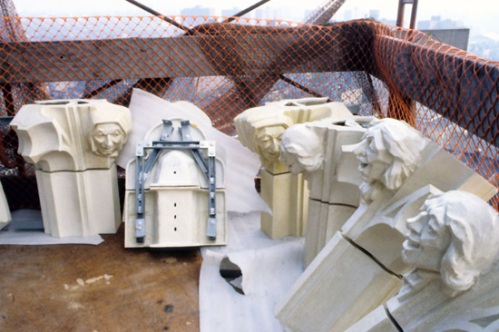
GFRC castings wait for installation. They are replicas of original terra cotta ornaments, created by craftsmen after studying vintage photos of the originals.
Correcting the flaws of the original design, Carl specified a substrate using a traditional masonry structure with the GFRC replicas bolted on to it using a steel framing system that accommodates adjustment in all three planes.
Shepard Hall’s dark gray Manhattan Schist, which was quarried from the very ground where Shepard Hall now stands, bore up under the decades much better than the terra cotta, but still had problems in places. Damaged stones were replaced with similar-looking granite.
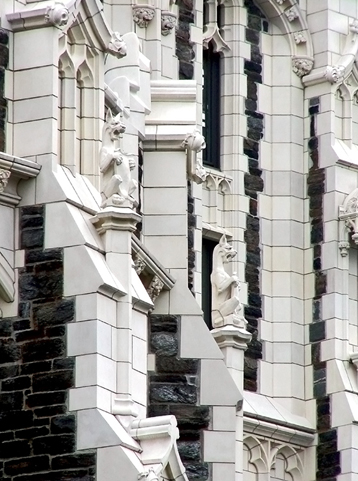
Dark gray Manhattan Schist and newly installed GFRC await cleaning and weatherproofing with PROSOCO products on Shepard Hall, during its ongoing restoration.
Where cleaning was needed, the preferred method was simply brush and water. When tougher measures were called for workers used Sure Klean Restoration Cleaner.
The technicians used Restoration Cleaner for areas of heavy carbon staining, a common problem on buildings from the coal-fueled early 20th Century.
Sure Klean Weatherseal SL100 Water Repellent was and is specified to weatherproof the cleaned and repaired sections of the building. The protective treatment is designed specifically for dense substrates like schist and GFRC.
“We chose SL100 because it’s highly breathable, and doesn’t create any appearance change,” Carl said. Along with short-circuiting the freeze-thaw cycle by blocking water penetration, the protective treatment also makes the surface easier to keep clean by stopping contaminants from soaking in, he added.
Work proceeded in nine separate phases, with a 10th and final phase set to kick off in late 2011.
Each phase addressed its own portion of the building, the order driven by severity of deterioration. “Life-threatening” conditions topped the list. With its four turrets beginning to bend outward, in danger of catastrophic failure, Shepard Hall’s main tower was first to get attention.
“We dismantled and rebuilt the upper 65 feet of the tower,” Carl said. This included the installation of four, 56-foot-tall structural post-tensioned precast concrete “masts” which were entirely clad with GFRC replicas, faithfully reproducing the original terra cotta forms.

Newly rebuilt, the upper 65 feet of Shephard Hall’s Main Tower awaits installation of GFRC.
A three-story bay window, one of six on the building, that had torn loose and collapsed led to another priority project. Investigation showed that all of the steel in these areas had deteriorated to the point of imminent failure. All six bay windows were carefully removed and replaced.
Inside, the building’s Great Hall, a cathedral-sized space 63 feet high, 185 feet long and 89 feet wide, was equally at risk. In its time, the hall boasted appearances by Albert Einstein, presidents William Howard Taft, Woodrow Wilson, and Franklin D. Roosevelt, and other luminaries.
Authorities closed the Great Hall in the 1980s because of the risk of masonry falling from upper parts of the window surrounds and other dangers. It stayed closed for 10 years.
By 1997, Carl and his team had put the Hall back in business, with a new limestone floor, new ventilation, lighting, acoustics, and voice and data systems — and restored stained glass windows with new surrounds. That work netted the firm a coveted Lucy G. Moses Preservation award.

Falling masonry and other safety hazards closed Shepard Hall’s cathedral-sized Great Hall for 10 years until it was restored with a new limestone floor, new window surrounds and more.
People caused some of the deterioration. In the 50s and 60s, Carl said, wooden doors and windows were replaced with aluminum. One of the building’s main entrances was taken for a concrete truck dock, which was later abandoned.
The entrance is now restored. Handsome oak door and window frames matching George Post’s original specifications have replaced the deteriorating aluminum frames.

Original oak doors were replaced with aluminum in the 50s and 60s, but were themselves replaced with new replicas, like this entrance to the Bell Tower, matching architect George Browne Post’s original specifications, during Shepard Hall’s epic restoration.
But weather, architectural flaws and human disregard for aesthetics aside, the biggest cause for the building’s descent into near-ruin was neglect, Carl said.
Several New York City budget crises, going back to the 50s, back-burnered maintenance for decades. With nothing to oppose it, weather found the weaknesses in the design and exploited them. By 1986, Shephard Hall was at a turning point where something had to be done — demolition or restoration.
Carl and his associates envisioned a 10-year plan to save the building. Its owners, the Dormitory Authority for the State of New York and City University of New York, agreed. The architects structured the plan to proceed as money became available.
While the vagaries of public funding have stretched the project out to more than two-and-a-half times its intended length, the work has methodically continued to where Shephard Hall, if not complete, is at least out of danger.
During the decades-long project, Elemental and nearly a dozen general contractors worked around building occupants, explored dozens of options for terra cotta replacement, and navigated a complex and constantly changing political and financial landscape to keep the epic project on track.
The payoff is that this landmark building, centerpiece of a campus that has produced more Nobel Laureates (nine) than any other public college, that has hosted presidents, will be around for a long time to come, Carl said.
“I look forward to seeing it completed,” he added.
# # #
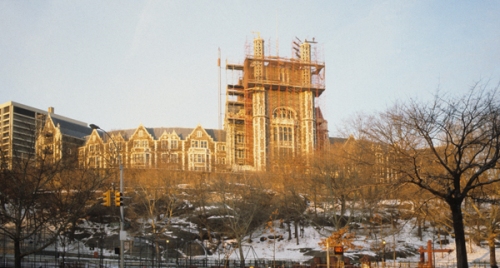
This long shot shows Shepard Hall’s Main Tower under reconstruction during the building's epic, ongoing restoration.
Read Full Post »



